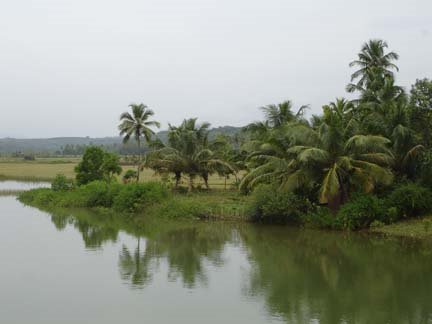Friday, December 17, 2010
262. Significance of Paisachi language
Wednesday, August 15, 2007
29.The Rice: Vrihi and Arih
Origin of the Sanskrit word ‘Vrihi’ that means rice (Oriza sativa) and sometimes other cereals like wheat and barley, has been discussed by Indological experts like Asko Purpola. The word is generally said to be not directly influenced by or related to the Dravidian words ‘arih’ (Tulu) and ‘arisi’ (Tamil) that represent the rice. On the other hand it has been fairly accepted that the Tamil word ‘arisi’ was adopted by Greek, Latin and also English as ‘rice’.
Sankaran Nair (2003) suggested that ‘Vrihi’ is a modified form of the word ‘varahi’. He cited that there are several varieties of rice designated as Graishmic, Hemanti, Varshic, Sharada, Salini etc described in ancient Sanskrit texts. Varahi is the female form of mythological Varaha, the boar incarnation of Lord Vishnu. (Varahi, is also the name of a river in Western Karnataka).
The word ‘Varahi’ has further ramifications. First connotation is that the Varaha was worshipped at that time by communities and cultures prevalent then at Pirak area. Spirits worshipped by the Tulu communities, even to date, include ‘Panjurli’ which is the Tulu form of Varaha. Appaently, the Panjurli or the Varaha was worshipped more widely at that time. The Varaha concept, later in the history, was absorbed as one of the ten incarnations of Lord Vishnu.
Thus the word ‘vrihi’ might have brought into Sanskrit usage as rice was predominantly grown and consumed by those who worshipped the Varaha or Panjurli. Besides, there is certain degree of similarity in pronunciation of the words ‘vrihi’ and ‘arih’.
ß
Saturday, February 17, 2007
3. Pirak, Prak and Prakrit
Pirak village in present day
Some of the early Tulu, Kannada and other Dravidian tribes that migrated from the Sumerian region as a consequence of natural calamities or famine there, possibly settled in the Pirak area. This was an important place where several cultural groups or tribes coexisted. It appears that migrant tribes from Sumeria,
It can be emphatically proposed that the Tulu tribes were distinctly there. A solid evidence in favour of this argument is that the word Pirak has been retained even today in the Tulu language. In Tulu pirak stands for something of ancient days (For ex: Avu baari pirakdaya! (=It is of very ancient days!), Pirakda kaladavu (=of ancient times).
Secondly, there were other tribes (Vedic Aryans?), who spoke a language known as pirak or prak in other areas. Later Prak language was further refined and adapted for writing and thus Sanskrit came into being. The Prak language, probably after the evolution of Sanskrit, was known as Prakrit.
The influence of Prak language (prakrit) on Tulu language is very strong. Many Tulu and Kannada words have been derived from prakrit. Similarly, it is also possible that words of early Tulu/Kannada language may have influenced formation of many words in prakrit.
Blog Archive
Books for Reference
- A Comparative Study of Tulu Dialects By Dr. Padmanabha Kekunnaya. Govinda Pai Reserach Centre, UDupi. 1994
- Koti Chennaya: Janapadiya Adhyayana. By Dr. Vamana Nandavar. Hemanshu Prakashana ,Mangalore.2001.
- Male kudiyaru. Dr B. A.Viveka Rai and D.Yadupathi Gowda, Mangalore University,1996.
- Mogaveera Samskriti By Venkataraja Punimchattaya. Karnataka Sahitya Academy.1993.
- Mugeraru:Jananga Janapada Adhyayana. By Dr Abhaya Kumar Kaukradi.Kannada & Culture Directorate,Bangalore & Karnataka Tulu Academy, Mangalore,1997.
- Puttubalakeya Pad-danagalu. Ed: Dr B.A.Viveka Rai,Yadupati Gowda and Rajashri, Sri Dharmasthala Manjunatheswara Tulu Peeta. Mangalore University.2004
- Se'erige. Ed:Dr K.Chinnapa Gowda.Madipu Prakashana,Mangalagangotri,2000.
- Studies in Tuluva History and Culture.by Dr P Gururaja Bhat (1975).Milagres College,Kallinapur,Udupi.
- Taulava Sanskriti by Dr.B.A.Viveka Rai, Sahyadri Prakashana,Mysore 1977
- TuLu naaDu-nuDi By Dr.PalthaDi Ramakrishna Achar, Puttur.
- TuLu NighanTu. (Editor in Chief: Dr U.P.Upadhyaya, Govinda Pai Research Centre,Udupi. Six volumes. 1988 to 1997
- Tulu Patero-A Philology & Grammar of Tulu Language by Budhananda Shivalli.2004.Mandira Prakashana Mangalore. p.317. (The book is in Tulu Language using Kannada script)
- TuLunadina ShasanagaLa Sanskritika Adhyayana. By Shaila T. Verma (2002) Jnanodaya Prakashana,Bangalore, p.304.(Kannada)
- Tuluvala Baliyendre. Compiled by N.A.Sheenappa Hegde,Polali,Sri Devi Prakashana,Parkala,1929/1999
* Landscape images *
A Coastal estuary

Holegadde near Honavar,Uttara Kannada dist, Karnataka
Copy? Right - but kindly remember to acknowledge!
" tulu-research.blogspot." ತುಳು ರಿಸರ್ಚ್. ಬ್ಲಾಗ್ಸ್ಪಾಟ್. ಇನ್

Have a nice day !
